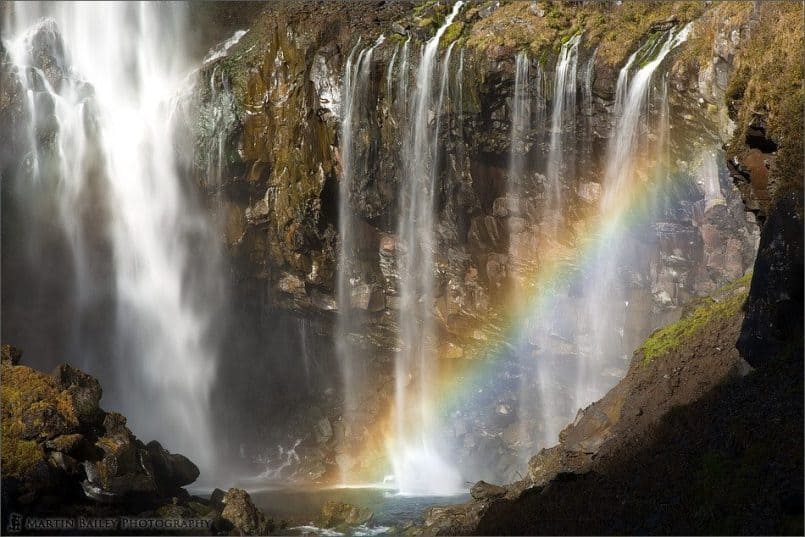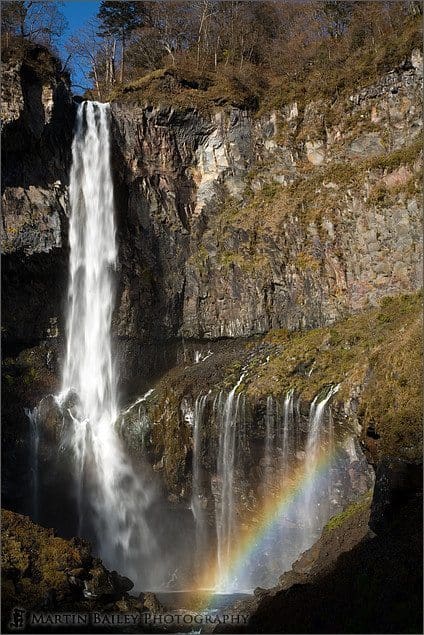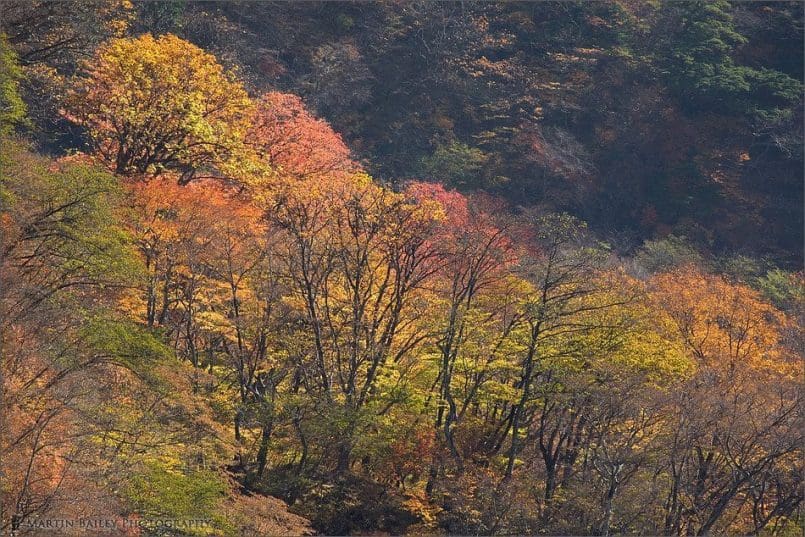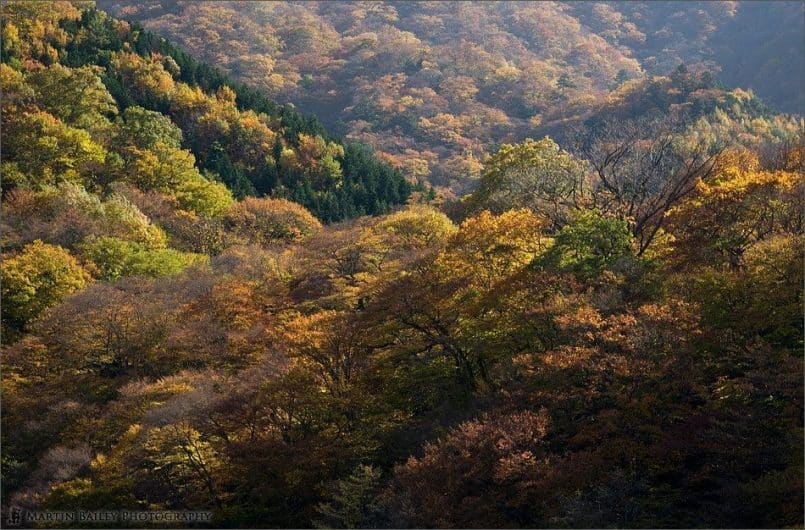Last week I took a holiday and hired a car, and have been off to the Touhoku district, which is the north-eastern area of Japan. This year the beautifully coloured Autumn leaves are about two weeks late, and are currently moving slowly south across Japan, and so many areas of north-eastern Japan are in full colour right now. Due to my main job responsibilities I would have found it very difficult to get any time off before now, so the lateness of leaves changing colour this year has helped me out a lot. Also, being busy in my day job stopped me from being able to plan my trip as much as I would have liked, but at the end of the day, I believe that successful photography trips are the result of good planning, but also good luck. So today I want to talk about these two things. I have not had time to post process all the photos I took at this point time, so I’m not going to talk about all of my experiences on the trip, but I want to briefly talk about both the planning and the luck aspects. If I think of anything else that I want to talk about on any particular shot during the remaining post processing I’ll follow up in a future episode. I will put a link to my site into the show notes though to enable you to view all shots from this outing, including the ones I’ve not yet uploaded.
Firstly, I decided that I would take out around five days to cover a pretty wide area, so I had to plan where I would be on which day, and ensure that I could get there in a reasonable time and have a good chance to get the shots I want.
The first thing I did was to look at my magazines. Japan has a lot of photography magazines, a number of which are like seasonal guides, that help you to plan where to go and when. These magazines are all written in Japanese, so I won’t go into details of the names etc. If anybody is interested drop me a line or post something in the forum and I’ll provide the details. Basically though, the seasonal guides provide information on areas that provide good photographic opportunities at a particular time of year, and also how to get there. They cover the whole of Japan too, so it’s easy to reference the areas you want to cover. There may well be similar magazines in your own countries too, so if you haven’t already, you might want to take a trip to the book store.
One problem with following this kind of publication is that you can end up making similar images to everyone else. I try to avoid getting the same shots as everyone else by ensuring that I continue to view scenes in my own individual way, and not trying to mimic the photos in the magazine. In fact, I often end up going to the same area, but visiting spots not mentioned in the magazine as they can sometimes be equally as beautiful or interesting. This is not really possible though if the main point of the trip is to visit something like a famous waterall. There’d be no point in visiting a famous place and only photographing the flowers at the edge of the car park. Of course though, these could be additional bonus shots from the trip if you have time. Anyway, it’s up to us as photographers to make the artistic decisions to not just replicate the shots that others have already made, as much as possible anyway.
Once I’ve figured out some places that I would like to visit, I use the Internet to check what the weather is likely to be like, and also in this case, I check the condition of autumn leaves in that area. This kind of backfired on me to a certain extent, as the leaves in the area I planned to visit the first day were although excellent in some areas, were pretty much already fallen in the area around the Chuuzenji Lake and the Kegon Falls in Nikko, which is in the Tochigi Prefecture a couple or three hours north of Tokyo by car. I had some luck here though, which I’ll get into in a moment.
Once I believe that I have a good chance of being in the right place at the right time, I start booking hotels. Again this is done via the Web.
Planning in this way can help to hedge your bets, and give you a better chance of getting some pleasing shots. Note that I’m using words such as hedging bets and chance. All types of photography which rely on natural elements such as the weather, seasonal changes, or people or even yourself, being in the right place at the right time, carry a certain amount of risk. For now, I’d got a different hotel booked for each of the four nights I’d be on the road, and booked a rental car to get me there. The rest was going to be down to me getting up early enough to catch the early morning light, and to luck.
As I said earlier, the leaves had already fallen in the higher altitude parts of the Nikko area when I got there, particularly around the Chuuzenji Lake, but there was something else that I wanted to shoot in this area, and that is the Kegon Waterfall. Something to note here is that in my planning I found it difficult just from looking at a map to find exactly which time of day the falls would be in shade, and so had decided to stay in a hotel near to the falls so that I could easily get to the falls on both the day I arrived, and early the following morning, doubling my chances of getting the falls in sunlight. On the afternoon I arrived having taken a steady drive from Tokyo during that morning, I visited the waterfall. It’s not easy to see the falls from the road without going along the Irohazaka road that takes you back down the mountain. This is a one way road, and get’s very crowded at this time of year, so I didn’t want to do that. What I did was the best way to view the falls, although the same as the hordes of people that visit each day, which is to pay $5 for a ticket to get ride on the elevator that takes you 100 metres down the mountain to a man-made platform in front of the falls.
As I walked out onto the platform on the first day, I found the falls in shade. I took a number of shots, but none were going to be that interesting, just another shot of the Kegon Waterfall on a dull day. I managed to get a number of shots with a blue sky, but the contrast between the falls in the shade and the bright sky meant that the sky would be blown out and just white. To get the sky well exposed, the waterfall would be so dark it would have been unrecognizable. The trees around the fall had also pretty much all lost their leaves, except for one on the cliff nearby that had some yellow leaves left. Including this tree though meant that the waterfall would have been too small in the frame, and again, another uninteresting shot. I did what I could and left, hoping to find something else of interest to shoot.
Anyway, the following morning I got up at 6AM having asked at the front desk at the hotel what time the sun would be coming up, and went for a walk down by the Chuuzenji Lake and took a few shots, but again nothing wonderful came out of this. The sunrise was pretty, but uneventful, so I couldn’t wait to finish breakfast and head back to the Kegon Waterfall. Hedging my bets by staying in the area definitely paid off, as when I returned to the waterfall shortly before 9AM and walked out onto the platform the view I was confronted with resulted in the first two shots that I want to show you today. The waterfall was in full sunlight and the mist rising from the pool at the foot of the falls was producing a beautiful little rainbow.
The two shots of the falls included in this Podcast are numbers 731 and 732, which as usual can be viewed on my Web site, martinbaileyphotography.com, buy entering the numbers one at a time into the field on the top page or my Podcast page which is linked to the toolbar and under the Podcasts section on the top page. You can also scroll down to find the episode in the list on the Podcasts page and click on the thumbnails to view the photos.
So back to the luck element I wanted to talk about here. Of course, a rainbow under these conditions is not that surprising, although I’d not really thought of it. Still I felt incredibly lucky. This feeling was confirmed over the next five minutes or so, as the rainbow was moving across the front of the falls as the sun moved across the sky, and was only visible for a very short time in the position you see in the photograph. It moved quickly to the right and then disappeared behind the rocks.
I’d given myself a chance to get this shot, by being able to visit the falls on both the first day of my trip and the following morning. But it was by shear luck that I was at the falls to capture the scene with the rainbow that lasted for what was probably no more than 10 to 20 minutes in total.
I’d also like to note here, that this week I received some advice from a listener about including the aperture, shutter speed and ISO settings etc. when talking about photos. I will do this when it makes sense to, and will do so today, but if ever you are interested, all of the shots on my Web site taken over the last few years have the shooting data displayed below the image when viewing the larger image having clicked a thumbnail. If the information is not shown, click the Information button above the image to display it. This is the black button with an “i” for information on it.
The first shot, 731, was made with a shutter speed of 1/10 of a second. The second shot, 732 was shot with a slightly faster shutter speed of 1/13 or a second. I used an aperture of F22 and ISO 50 for both shots, as I wanted to get a slow enough shutter speed to give an impression of the water flowing. I thought about dropping on a neutral density filter to allow myself to get an even slower shutter speed, but I didn’t think I was going to have enough time to mess around with the neutral density filter as the rainbow was moving across the front of the falls relatively quickly and I wanted to get enough shots to ensure I got a winner. What I did do though was to drop a circular polarizing filter from my pocket onto the lens. A PL filter usually costs you around 2 stops of light so the shutter speed dropped from 1/50 of a second to 1/10, which was enough to give a flowing effect in the water without going over the top. Something to note here though is that I had to ensure the PL filter was positioned so that it did not reduce the colours in the rainbow. A rainbow is basically just light reflecting off water, which is exactly what a polarizer will cut out, so as I turned the filter to check the effect, at some points the rainbow completely disappeared, and I obviously didn’t want that. Having checked the shots with and without the PL filter, the end results had no difference in colour, just the slower shutter speed has increased the flow of the water, as anticipated, so it was probably not a bad move.
I should also mention here that in episode 5 of the Martin Bailey Photography Podcast, in which I did a review of the Canon EOS 5D digital SLR camera, I mentioned that I found the Landscape Picture Style setting too gaudy, and would probably not be using it. I need to take this back to a certain extent. Although I do find the Landscape Picture Style too loud for brightly coloured objects like flowers, often making the colour look very digital, I found that the Landscape Picture Style brought the images of the Autumn leaves to life quite nicely. I will continue to shoot RAW with the Picture Style set to Standard mode, as this gives a great base to start from, but I do now think that there is a place for the Landscape Picture Style, when there is not already a lot of bright colour in the shot. I’m actually really pleased about this, as for a while there I really couldn’t figure out what Canon were thinking on this one.
So, pleased with the fact that I’d got a few nice shots of the waterfall, I decided to move on to my next location. I’m not going to talk about the other locations during my trip in this episode, but the thing I was looking forward to about moving on to today, was that it was going to take me down the Irohazaka road, which I was hoping was going to allow me to see some beautifully coloured Autumn trees. That is, if the Web site I’d checked the conditions of the leaves on was not wrong about this area too. I had traveled up the other side of this mountain the previous day and was not all that impressed, but the only area I had not yet seen was the descending road, and if the leaves had fallen on this road too, I really didn’t know where the site had gotten their information from.
Anyway, although some of the trees had lost their leaves the drive down the Irohazaka Road was still pretty spectacular. The third shot of this episode was a scene I closed in on with my 100 – 400mm L lens about half way down the mountain. This is number 733. I had to stop at the side of the road, and it is quite busy so you need to be careful in these situations, but as long as you ensure you are off the road, you are usually going to be OK. This shot was made at F11 for 1/13 of a second, using a tripod. The next and last shot for today, number 738, was at the bottom of the mountain as the road levels out, and was shot handheld at F8 with a shutter speed of 1/25 of a second. Both shots were at ISO 100.
I spent the next three and a half days traveling around the Touhoku area of Japan, and the Web site that I’d used to check if the autumn leaves were in full colour and not yet fallen turned out to pretty accurate for all the other locations. I should also say that I tend to plan trips in which I’ll do a lot of traveling so that I’m in certain areas during the times when the light is best a few hours after dawn and a few hours before dusk. I’ll often stop off somewhere along the way too, but I find that traveling either after dark or during the hours in the middle of the day when the light can be quite harsh allows me to cover a lot of ground without feeling too bad about wasting daylight.
Also note that when planning, although weather forecasts are not always accurate at the best of times, mountainous areas usually create their own weather, so be prepared to have your hopes dashed if you wanted good weather. I do feel though, that good weather will not always enable you to get the best results. One place I had visited called the Naruko Gorge, in the Miyagi Prefecture was much more spectacular in the rain and mist on the first day than in full sunshine the following morning. It is always good to carry some kind of protection from the rain, such as some waterproof over-wear to keep yourself dry, and a plastic cover for you camera or an umbrella to keep your gear dry. I took both, but only needed the umbrella when shooting the Naruko Gorge as it was not far from the car. The problem with an umbrella though is it is awkward to hold at the same time as shooting. So you either need a willing helper, or suffer trapping the handle of the umbrella with the side of your face like a telephone. Anyway without going too far off track, if you are interested, please keep your eyes open on my Web site at martinbaileyphotography.com for shots from this location.
I guess to summarize; I think planning, using available information such as magazines and the internet, is definitely necessary. If I had more time, I always feel as though I could do a much better job of my planning for trips. An important thing that I try to do though is to make sure I can visit the same site a number of times, and I travel when the light is harsh. Having gotten to your location, getting up early or going the extra mile to visit a few times will always increase your chances of getting the shot. Then, it really is down to luck. Like me with the rainbow that I was lucky to encounter at the Kegon waterfall, I wish you all good luck in your shooting too.
If you have any planning tips or tricks that you’d like to share, please post them in the forum at martinbaileyphotography.com. Same goes for any questions or other feedback. If you would rather just contact me directly about anything, there’s a contact form on the Podcast page. I look forward to hearing from you.
Speak to you next week.
Show Notes
The Music in the first 28 Podcasts is copyright of William Cushman © 2005, used with kind permission.
Subscribe in iTunes for Enhanced Podcasts delivered automatically to your computer.
Download this Podcast in MP3 format (Audio Only).







0 Comments